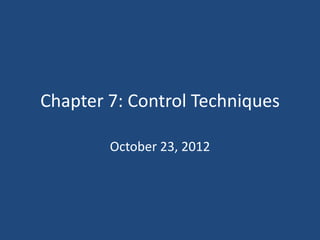
Chapter 7 class version(1)
- 1. Chapter 7: Control Techniques October 23, 2012
- 2. Roadmap • Discuss Reflection Assignment #2 – Due Nov. 1 via BlackBoard • Coming Up: Exam #3 next Tuesday, Oct. 30 • Quick review • Chapter 7
- 3. Factorial Designs • When to use • Main and interaction effects • Effect patterns in data displays
- 4. Overview Control Techniques • Control at the beginning of experiment – Random assignment Create equivalent – Matching experimental groups • Control during the experiment – Counterbalancing Treat groups the same – Controlling for participant effects during the – Controlling for experimenter effects experiment
- 5. Methods for Matching Participants • Holding variables constant • Building the extraneous variable into the design • Yoked control • Equating participants
- 6. Matching by Holding Variables Constant • Hold extraneous variable constant for all groups in the experiment • All participants in each treatment group will have same degree or type of extraneous variable • Requires selection criteria for participant sample
- 7. Build Extraneous Variable into the Research Design • Especially useful if you are interested in: – Differences produced by the levels of the extraneous variable – Interaction between levels of IV and levels of extraneous variable • Sound familiar? – What kind of research design would this be?
- 8. Example: Effect of a study skills intervention on grades in a Quantitative Methods course Intensive tutoring program Study packets (usual) But the literature suggests that learning style may affect how students respond to different study skills training methods. Learning style is a potential confounding extraneous variable….but we can build it in to the design! Learning Style Visual Auditory Kinesthetic Intervention Intensive tutoring program Study packets
- 9. Matching by Equating Participants Precision control • Match each participant in experimental group with a participant in control group on variable(s) of concern • Example: Scholtz (1973) compared defense styles in suicide attempt vs. no attempt
- 10. Matching by Yoked Control • Match participants on the basis of the sequence of administering an event • Each control participant is “yoked” to an experimental participant • Controls for the possible influence of participant-controlled events • Example: Sklar & Anisan (1979) – stress and immune response
- 11. www.xkcd.com CONTROL DURING THE EXPERIMENT
- 12. Control During the Experiment • Must treat the different groups in the same way during the experiment, except for administration of the IV • Why is this important?
- 13. • Control during the experiment – Counterbalancing within-participants designs – Controlling for participant effects – Controlling for experimenter effects
- 14. Counterbalancing • Used to control for sequencing effects in a repeated measures (aka within-subjects) design • Sequencing effects occur when participants participate in more than one condition • Two types of sequencing effects – Order effect – Carryover effect
- 15. Counterbalancing • Order effect – “Arises from the order in which treatment conditions are administered to participants” – Treatment/experiment exposure can influence performance on subsequent tasks and measures – Most common: • Practice effect • fatigue
- 16. Counterbalancing • Carryover effect – Performance in one condition is affected by the condition that precedes it – Example: Participant receives active drug before the placebo, and the residual effects are still present during placebo condition • One strategy: “wash-out” period
- 17. Counterbalancing Techniques • Randomized counterbalancing individual • Intrasubject counterbalancing • Complete counterbalancing group • Incomplete counterbalancing
- 18. Types of Counterbalancing • Randomized counterbalancing – Sequence order is randomly determined for each individual – Just like random assignment to conditions – You do not decide the sequence, must use a random process to decide order
- 19. Types of Counterbalancing • Intrasubject Counterbalancing – When each participant receives all levels of the IV more than one time – Have participants take conditions first in one order, then again in the reverse order – Disadvantage: Participant burden is increased • Must complete each condition more than once
- 20. Types of Counterbalancing • Complete and Incomplete counterbalancing – Group counterbalancing – Determine possible sequences – Randomly assign to sequence such that sequences are distributed across groups rather than individuals
- 21. Participant Effects • Demand characteristics – Cues in the experiment that might influence participant behavior • Positive self-presentation – Motivation for participants to present themselves in a positive light
- 22. Control of Participant Effects • Deception – Giving participants a bogus rationale for the experiment • Can range from minor deceit to more elaborate schemes Classic example: Milgram studies
- 23. Control of Participant Interpretation • Previously discussed methods provide good control for demand characteristics of study • But how do we know what participants’ perceptions of our study are? – Ask them!
- 24. Control of Participant Interpretation • Retrospective Verbal Reports: after experiment – Disadvantage: Participants might forget perceptions by the end of the study • Concurrent Verbal Reports: during experiment – Solomon’s Sacrifice Groups – Concurrent probing – Think-aloud technique
- 25. Control of Experimenter Effects • Experimenter effects – The biasing influence that can be exerted by the experimenter • Data Recording errors--control – Be careful – Multiple observers and data recorders – Keep experimenter blind to participants’ conditions – Electronic or mechanical data recording*
- 26. Control of Experimenter Effects • Experimenter Attribute Errors – Some experimenters, because of their attributes, produce more of an effect than other experimenters • Control technique: – Experimenters should run all conditions – Experimenters same on characteristics that might affect DV
- 27. Control of Experimenter Effects • Experimenter Expectancy Errors – Experimenter’s expectations about the study influence participant responses Control techniques: • Blind technique • Partial blind technique • Automation
- 28. Ideal: Control Participant AND Experimenter Effects • Double-Blind Placebo Method – Participant and experimenter blind to condition – “Devise manipulations that appear essentially identical to research participants in all conditions” – Example: Compare drug to identical sugar pill (placebo)